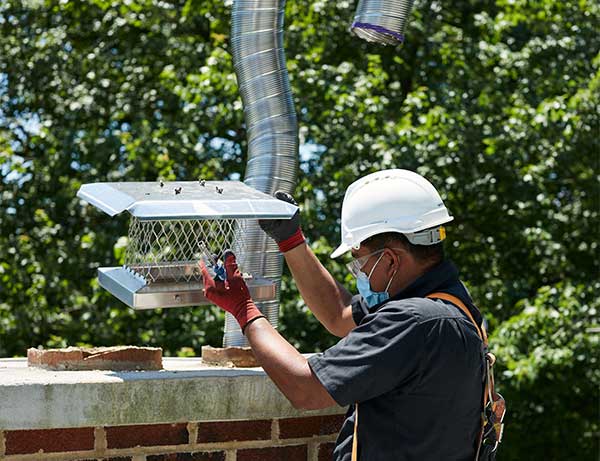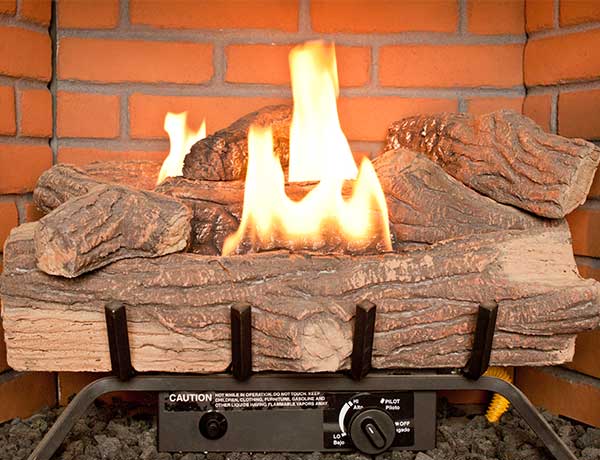If you’ve heard about the many benefits of using gas fireplaces, then it’s no surprise that countless homeowners have invested in them for warmth and ambiance. And among the gas fireplace options available out there, ventless gas fireplaces have gained popularity for their convenience and efficiency.
However…while these fireplaces offer numerous benefits, they also come with a set of significant downsides and potential risks that should not be overlooked.
We’re here to shine a light on these, ensuring homeowners in Northern VA can make the most informed decisions about their heating options – prioritizing the safety and well-being of their families every step of the way. Questions? Give us a call or reach out online – we’re here to help.

1. Your Air Quality Could Suffer
The combustion process in ventless gas fireplaces releases various byproducts, including carbon monoxide (CO) and nitrogen dioxide (NO2), directly into the indoor environment. These byproducts can have detrimental effects on indoor air quality and, consequently, on the health and well-being of occupants.
Furthermore, flame impingement – where the flame comes into direct contact with surfaces such as walls or furniture – can exacerbate indoor air quality issues. This can lead to incomplete combustion, which increases the production of pollutants, such as carbon monoxide and soot.
What are carbon monoxide (CO) and nitrogen dioxide (NO2)?
- Carbon monoxide is a colorless, odorless gas that can be deadly in high concentrations, as it interferes with the body’s ability to transport oxygen to vital organs.
- Nitrogen dioxide is a toxic gas that can irritate the respiratory system and exacerbate respiratory conditions such as asthma.
Do ventless gas fireplaces have safety sensors?
Yes – most modern gas fireplaces are equipped with oxygen depletion sensors (ODS) that monitor the oxygen levels in the room and automatically shut off the fireplace if oxygen depletion is detected.
That said, reliance solely on these sensors may not fully mitigate the risks associated with poor indoor air quality. Adequate ventilation is crucial to dilute the concentration of combustion byproducts and maintain a healthy indoor environment. Without proper ventilation, these byproducts can accumulate to hazardous levels, even with the presence of an ODS.
In addition, be sure to invest in carbon monoxide detectors, as well as book regular professional maintenance and inspections.
2. You Could Experience Excess Moisture (& Related Damage)
The combustion process in ventless gas fireplaces not only releases gases like carbon monoxide and nitrogen dioxide, but also produces water vapor as a byproduct. While water vapor itself is not harmful, excessive accumulation of moisture indoors can lead to a host of problems – including issues with mold and mildew.
What are the risks involved with mold and mildew growth?
Mold and mildew pose numerous health risks to occupants. Exposure to mold spores can trigger allergic reactions, respiratory problems, and other health issues, particularly for individuals with allergies or asthma.
To mitigate the risk of mold and mildew growth associated with ventless gas fireplaces, proper ventilation is essential. Adequate airflow helps to disperse moisture and prevent it from accumulating on surfaces. This may involve using exhaust fans, opening windows periodically, or installing a mechanical ventilation system to ensure proper air exchange.
3. You Could Experience Potential Safety Risks
While ventless gas fireplaces come equipped with safety features designed to mitigate potential hazards, some individuals remain cautious about using them in their homes – particularly without external venting.
Take the following actions to mitigate any risks:
- Invest in professional installation. Ventless gas fireplaces have specific requirements for proper placement, clearances, and ventilation to ensure safe operation. Deviating from these guidelines can compromise the fireplace’s performance and pose safety risks to occupants – trust a professional for your gas fireplace installation services.
- Install a carbon monoxide detector. Installing a carbon monoxide (CO) detector in the room where the ventless gas fireplace is located is strongly recommended. Since CO is colorless and odorless, properly functioning carbon monoxide detectors can alert occupants to the presence of this gas.
- Be cautious with ceiling fans. Ceiling fans create air movement that can disrupt the natural flow of the flame and potentially cause flame impingement, where the flame comes into direct contact with surrounding surfaces. This can lead to incomplete combustion, increased production of pollutants, and safety hazards.
- Book annual chimney inspections. Regular maintenance of the ventless gas fireplace is also important in preventing moisture-related issues. Cleaning the fireplace and inspecting it for any leaks or malfunctions can help ensure efficient operation and reduce the likelihood of excess moisture being released into the indoor environment.
4. You Could Experience Less Heat
While ventless gas fireplaces excel at providing localized heat and creating a cozy atmosphere in smaller spaces, they may not be the most effective solution for heating large areas or open floor plans.
This limitation stems from the way heat is distributed and dispersed by these fireplaces, which can result in uneven temperature distribution throughout the room. While one of the key characteristics of ventless gas fireplaces is their ability to emit radiant heat (which warms objects and surfaces in close proximity to the unit), the heat generated by the fireplace tends to concentrate only around the immediate area.
Moreover, the effectiveness of ventless gas fireplaces in heating larger areas can be further limited by factors such as room layout, ceiling height, and insulation levels. Rooms with high ceilings or poor insulation may experience greater heat loss, reducing the overall efficiency of the fireplace and exacerbating temperature differentials within the space.
Give Us a Call With Questions
Whether you have concerns about your current fireplace, questions about maintenance, or just to schedule an upcoming service or repair, we’re here for you.
Don’t wait to reach out – our experts are standing by!



